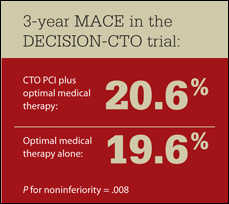CTO PCI: Should We Do, Rather Than Can We Do?
Chronic total occlusion is commonly observed in patients who undergo coronary angiography. Successful recanalization of CTO can improve patient symptoms, as assessed by the Seattle Angina Questionnaire. However, the treatment of CTO represents a challenging lesion subset for PCI.
Improvements in Technique, Equipment
In recent years, improvements in techniques and specialized equipment have increased the procedural success rates as well as the number of operators who have attempted these technically challenging cases.

The number of CTO PCI cases as well as industry-sponsored training programs for interventional cardiologists continue to grow in popularity. These cases can take several hours, exposing the operator and patient to radiation.
Multiple wires, microcatheters like the Corsair (Asahi Intecc) and the CrossBoss coronary CTO crossing catheter (Boston Scientific) and the Stingray coronary CTO re-entry system (Boston Scientific) can significantly increase the cost of the PCI.
New Data, New Questions
However, randomized trial data showing clinical benefit of CTO PCI are limited.
Results of the DECISION-CTO trial were reported at the American College of Cardiology Scientific Session in March 2017. The trial included 798 patients with at least one CTO across nine cardiac centers in Asia.

According to results presented, routine CTO PCI along with optimal medical therapy including aspirin, a beta-blocker, a calcium channel blocker and a statin did not reduce CV events compared with optimal medical therapy alone. The procedural success rate for CTO PCI was > 90%. The primary endpoint of 3-year MACE, defined as a composite of death, MI, stroke and repeat revascularization were similar (see Graphic). Results did not change at 5-year follow-up. The endpoint that one would have thought to improve with successful CTO PCI — quality-of-life measures, including the Seattle Angina Questionnaire for angina — was similar to optimal medical therapy.
Additional Considerations
If a patient is being evaluated for CTO PCI, the operator should consider the cost of the procedure; the clinical benefit of successful recanalization and improvement in angina; and the potential risks of the procedure, such as periprocedural MI, perforation, vascular access site complications and the impact on renal function due to large volumes of contrast media.
Given the results of the DECISION-CTO trial, my take is that routine treatment of CTO should not be performed unless patients have refractory angina despite being on optimal medical therapy. Another subset of patients who may benefit from CTO PCI are patients with severe cardiomyopathy and viable myocardium in the distribution of the target lesion. Patients with multivessel disease who are not ideal surgical candidates may also be evaluated for CTO PCI.
Call for Future Research
The operator should temper the enthusiasm and only perform CTO PCI if clinically indicated and the patient will likely derive clinical benefit, especially in patients with refractory angina as well as those with large ischemic burden in the territory of the CTO.
Further trials are needed to identify which patients will benefit from CTO PCI.
- References:
- Borgia F, et al. Int J Cardiol. 2012;doi:10.1016/j.ijcard.2011.04.023.
- Jeroudi OM, et al. Catheter Cardiovasc Interv. 2014;doi:10.1002/ccd.25264.
- Park SJ, et al. Late-Breaking Clinical Trials: Interventional. Presented at: American College of Cardiology Scientific Session; March 17-19, 2017; Washington, D.C.
- For more information:
- Michael S. Lee, MD, FACC, FSCAI, is an interventional cardiologist and associate professor of medicine at UCLA Medical Center. He can be reached at 100 Medical Plaza, Suite 360, Los Angeles, CA 90095; email: mslee@mednet.ucla.edu.
Disclosure: Lee reports he receives consultant fees from Cardiovascular Systems Inc.
